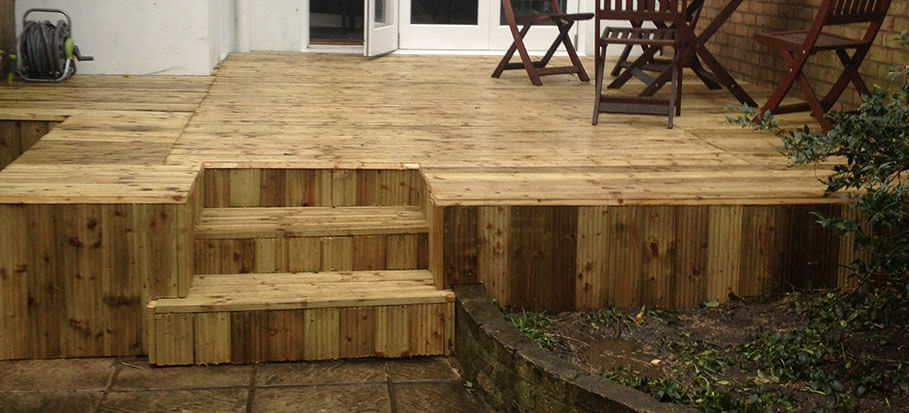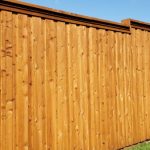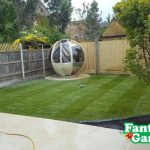
Colder, darker winter nights and piles of fallen leaves often add up to some seriously slippery decking in your garden.
We might not be able to convince the UK weather to become a constant Malibu sunshine. But we can make sure that our decking stays safe to walk on all year round.
Here are a few basic things you can do to keep your decking safe and dry!
Table of Contents
How does decking become slippery?
Let’s start with the basics. What causes slippery decking?
Wood is porous
Most wood isn’t a sealed substance. Many types of wood can quickly become impregnated with water as liquid gathers between the fibres of the material.
To prevent this, wood needs to be treated either by your supplier or by you or your garden landscaper after it’s been put in place. You also need to be sure that there are no areas of your decking where water might naturally pool.
Algae, moss, mould, and other growth
If water or even moisture regularly collects on your decking, it can lead to ideal conditions for algae, moss, and other growth to form.
This is often exacerbated in winter conditions, which tend to include less sunlight and lower temperatures.
Leaves and other debris
Debris which builds up on the surface and in the corners of your deck is one of the leading causes of slippery decking.
Leaves and debris are a potential source of slippery danger in and of themselves. But they can also encourage algae, mould, fungus, and other growth to appear. Especially when they get wet and are allowed to remain in place.
How to stop decking from being slippery
It’s not possible to make decking non-slip by waving a magic wand. However, there are some simple steps you can take in order to improve the slip-danger levels of your decked areas.
Always clear leaves and debris
The simplest step is the regular removal of leaves and other wet debris which are the major cause of slipping accidents. The build-up of these elements tends to start in autumn. If they are allowed to continue accumulating into winter, that’s when you’re going to start seeing more serious problems.
Luckily, the solution to this is simple. All you need to do is use a brush with stiff bristles to clear away the dirt and leaves every week or two.
Tackle algae and moss
Algae and moss can be a big problem if they’re allowed to get a foothold on your decking. Most modern decking boards have grooves which make it more difficult for moss and algae to get a hold of them.
But whether you have grooved boards or not, it’s a good idea to:
- Regularly run a quick sweep of your deck to check for green speckles or markings.
- Apply a good moss or algae killer to any areas which look to be affected.
Put down rubber mats
A quick and easy solution which many decking owners resort to is to put down rubber mats to protect their decking during the winter and autumn months.
Mats are a pretty basic idea – as opposed to other anti-slip decking treatments you can get – but they have the advantage of being simple to apply and simple to remove whenever you want.
All you need to do is put down the weatherproof mats, allow them to take the brunt of the winter weather for your decking and then remove them when spring comes around.
Remove ice (safely!)
Any water or moisture which collects on your decking can lead to one additional slip danger when the weather turns much colder: ice.
It’s obvious enough that ice needs to be removed from decking. But most people’s go-to solutions – either putting down heaps of grit or attacking it with a shovel or another metal gardening tool – are not the best ways to proceed.
Even the most careful use of a metal tool can lead to your decking being damaged. Meanwhile, grit contains chemicals which can damage both the metal and wooden components of your decking – unless it’s made of a composite material.
Be sure to safely remove any ice using a plastic tool or by using a very small amount of grit and carefully rinsing it away after it has done its job.
Try non-slip decking strips or adhesive tape
Non-slip decking strips and tape are specially-designed products. They’re sort of like permanent or semi-permanent versions of the rubber mats which many people use to protect their decking during the winter months.
You can get these kinds of products in various forms:
- Non-slip decking strips – these are permanent additions to your decking. Usually screwed into the wood of your deck, they can’t normally be easily removed. But they do create a much safer area of decking which will never have any problems with being slippery.
- Anti-slip tape for decking – this is a non-permanent adhesive tape which can be stuck to any problem areas of decking. The tape will degrade over time and need to be removed. But it is much more affordable and less permanent than the screwed-in strips.
Of course, both these types of decking protection need to be put in place before you start having problems with the damp. They don’t work well when your starting point is wet decking.
Think about a slip-resistant coating
If you’re wondering how to make decking non-slip and you already have a built deck in place, a full slip-resistant coating is the high-bar solution.
Usually applied to grooved-type decking boards, this coating fits in between the grooves to protect against the formation of algae, moss, and other troublesome green growth which is such a major cause of slippery decking.
If you haven’t had your decking installed yet – or it’s reached the point where it needs to be replaced rather than repaired – a slip-resistant coating will be one of your better options. The other is a fully non-slip deck.
Opt for a full non-slip deck
If you haven’t built your deck yet – but are already sensibly concerned about keeping it in good condition, free from being wet and slippery all year round – choosing to build with non-slip timber decking is an option definitely worth considering.
Purpose-designed non-slip decking is also a good option if you’re looking into completely replacing decking that’s deteriorated in condition specifically because of water, damp, algae, or other common problems which a specially-designed deck can protect you from.
This kind of deck is constructed from anti-slip boards. These boards are built with several of the features mentioned here already built-in. They are commonly treated with anti-fungal, anti-insect protection and have non-slip strips which are already part of them.
But no matter whether you have decking already in place or you’re looking at a new build or replacement, taking steps to protect your deck from the possible dangers that being slippery is associated with is only sensible.
Whether you’re handling the installation yourself or using a reliable garden landscaper to fit or improve your decking, how you will stop your decking from being slippery is definitely an issue that you should be thinking about or discussing.
Having trouble installing your own decking? Call the professionals!
Enter your postcode to view our rates and availability in your area.
For questions about the services we offer visit our main site




This is really good information. Sealing the deck is probably the best remedy to this, but, it’s not a “one-time” cure all. wood that is exposed to the elements year round is very susceptible to these slippery conditions and regularly scheduled maintenance will go a long way in prevention. Pressure washing and sealing are your best defense. It’s also not a crime to seal exposed wood once a year, a little extra sealer isn’t going to hurt a thing.
very well written content. Keep up the good work!!